Related Research Articles

Geopyxis carbonaria is a species of fungus in the genus Geopyxis, family Pyronemataceae. First described to science in 1805, and given its current name in 1889, the species is commonly known as the charcoal loving elf-cup, dwarf acorn cup, stalked bonfire cup, or pixie cup. The small, goblet-shaped fruitbodies of the fungus are reddish-brown with a whitish fringe and measure up to 2 cm across. They have a short, tapered stalk. Fruitbodies are commonly found on soil where brush has recently been burned, sometimes in great numbers. The fungus is distributed throughout many temperate regions of the Northern Hemisphere. It is found in Europe, Turkey, and North America. Although it is primarily a saprotrophic species, feeding on the decomposing organic matter remaining after a fire, it also forms biotrophic associations with the roots of Norway spruce.

Cerocorticium is a genus of seven species of crust fungi in the family Meruliaceae.
Skepperia is a genus of fungi in the family Thelephoraceae. The genus was described by mycologist Miles Joseph Berkeley in 1857 to contain the type species Skepperia convoluta. The genus was circumscribed by Berkeley in Trans. Linn. Soc. London vol.22 on page 130 in 1857.
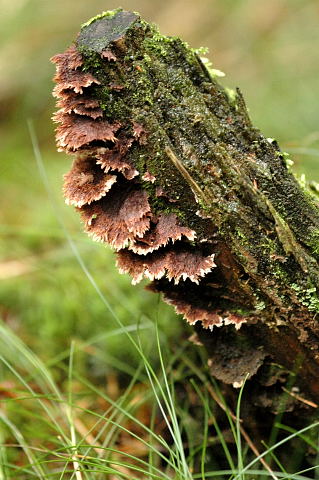
Thelephora is a genus of fungi in the family Thelephoraceae. The genus has a widespread distribution and contains about 50 species. Fruit bodies of species are leathery, usually brownish at maturity, and range in shape from coral-like tufts to having distinct caps. Almost all species in the genus are thought to be inedible, but Thelephora ganbajun is a gourmet fungus in Yunnan province of southwest China.

Marasmius rotula is a common species of agaric fungus in the family Marasmiaceae. Widespread in the Northern Hemisphere, it is commonly known variously as the pinwheel mushroom, the pinwheel marasmius, the little wheel, the collared parachute, or the horse hair fungus. The type species of the genus Marasmius, M. rotula was first described scientifically in 1772 by mycologist Giovanni Antonio Scopoli and assigned its current name in 1838 by Elias Fries.
Episphaeria is a genus of fungus in the Agaricales. The genus is monotypic, and contains the single rare species Episphaeria fraxinicola, found in Europe. Its familial position is not known with certainty. The tiny fruit bodies of the fungus resemble minute, white cups that grow scattered or in groups on the bark of ash trees.
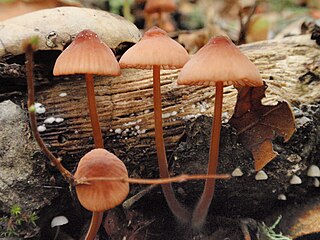
Mycena californiensis is a species of fungus in the family Mycenaceae. It is a common and abundant species in the coastal oak woodlands of California, where it grows saprobically, feeding on the fallen leaves and acorns of various oak species. First described in 1860 by Berkeley and Curtis, the species was collected four years earlier during an exploring and surveying expedition. It was subsequently considered a doubtful species by later Mycena researchers, until a 1999 publication validated the taxon. Mycena elegantula is considered a synonym.

Caripia is a fungal genus in the family Marasmiaceae. The genus is monotypic, containing the single species Caripia montagnei, commonly known as the pod parachute. It is found in tropical and subtropical regions of the Americas. Formerly classified in the Stereales, molecular analysis published in 2002 demonstrated that the fungus is a reduced form of the closely related Gymnopus.

Leucocoprinus fragilissimus, commonly known as the fragile dapperling, is a species of gilled mushroom in the family Agaricaceae.
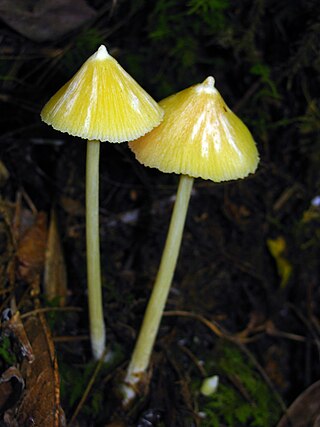
Entoloma murrayi, commonly known as the yellow unicorn Entoloma or the unicorn pinkgill, is a species of fungus in the Entolomataceae family. First described from New England (USA) in 1859, the species is found in eastern North America, Central and South America, and southeast Asia, where it grows on the ground in wet coniferous and deciduous forests. The fungus produces yellow mushrooms that have a characteristic sharp umbo on the top of a conical cap. The mushroom is inedible and may be poisonous. Other similar species can be distinguished from E. murrayi by differences in color, morphology, or microscopic characteristics.
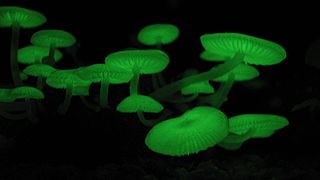
Mycena chlorophos is a species of agaric fungus in the family Mycenaceae. First described in 1860, the fungus is found in subtropical Asia, including India, Japan, Taiwan, Polynesia, Indonesia, and Sri Lanka, in Australia, and Brazil. Fruit bodies (mushrooms) have pale brownish-grey sticky caps up to 30 mm (1.2 in) in diameter atop stems 6–30 mm (0.2–1.2 in) long and up to a millimeter thick. The mushrooms are bioluminescent and emit a pale green light. Fruiting occurs in forests on fallen woody debris such as dead twigs, branches, and logs. The fungus can be made to grow and fruit in laboratory conditions, and the growth conditions affecting bioluminescence have been investigated.

Discinella terrestris is a species of fungus in the family Helotiaceae. It was first described as Helotium terrestre by Miles Joseph Berkeley and Christopher Edmund Broome in 1882, from collections made in Brisbane. R.W.G. Dennis transferred it to the genus Discinella in 1958.
Pluteus aethalus is a species of agaric fungus in the family Pluteaceae. It is found in Cuba. The species was originally named Agaricus aethalus by Miles Joseph Berkeley & Moses Ashley Curtis in 1869, and later transferred to the genus Pluteus by Pier Andrea Saccardo in 1887. It is classified in Pluteus section Celluloderma, subsection Mixtini.
Roridomyces subglobosus is a species of fungus in the genus Roridomyces, family Mycenaceae.
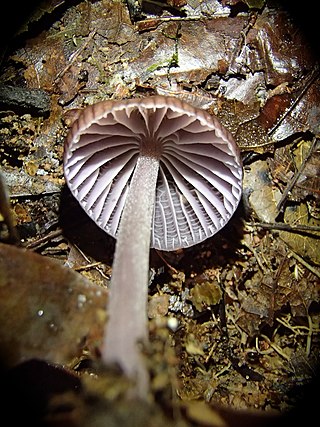
Mycena holoporphyra is a species of agaric fungus in the family Mycenaceae. It was first described by Miles Joseph Berkeley and Moses Ashley Curtis in 1868 as Agaricus holoporphyrus. Rolf Singer transferred it to the genus Mycena in 1962, where it is classified in the section Calodontes. First described from Cuba, it is also found in Trinidad, Africa, Mexico, and Central America and South America.Nicolas Niveirio, Orlando F. Popoff, and Edgardo O. Alberto, classify Mycena Holoporphyra for their distinguishable basiodiocarps that are violet or purple, having a radish like smell, fungal tissues, and a lack of pleurocystidia. In addition, Pegler, describes the species as having a pale cream spore print with spores of ellipse cylindrical to oblong cylindric, hyaline and deeply amyloid.

Nigroporus vinosus is a species of poroid fungus in the family Steccherinaceae, and the type species of the genus Nigroporus. Its fruit bodies have brownish caps with tinges of purple or red. The cap underside has a pore surface the same colour as the cap, and minute pores. Nigroporus vinosus has a pantropical distribution. It has been recorded from Africa, North America, Central America, South America, Asia, and Oceania. It is a wood-decay fungus that causes a white rot.

Loweomyces fractipes is a species of poroid fungus in the family Steccherinaceae, and the type species of the genus Loweomyces. It is a widely distributed species, found in North America, Europe, Central America, South America, and Korea.
Harzia is a genus of seed-borne fungus that occurs in the soil. It has been categorized in the Ceratostomataceae family. The genus Harzia originally contained three accepted species: Harzia acremonioides, Harzia verrucose, and Harzia velatea. Within the genus Harzia, Harzia acremonioides is one of the most common species that can be found in all climate regions around the world.
Leucocoprinus biornatus is a species of mushroom producing fungus in the family Agaricaceae.
Leucocoprinus holospilotus is a species of mushroom producing fungus in the family Agaricaceae.
References
- ↑ "GSD Species Synonymy: Cerocorticium molle (Berk. & M.A. Curtis) Jülich". Species Fungorum. Kew Mycology. Retrieved 2018-04-17.
- 1 2 Nakasone, Karen K. (2015). "Taxonomic studies in Chrysoderma, Corneromyces, Dendrophysellum, Hyphoradulum, and Mycobonia" (PDF). Mycotaxon. 130 (2): 369–397. doi:10.5248/130.369. Archived from the original (PDF) on 2022-01-24. Retrieved 2018-06-10.

- ↑ Saccardo, P.A. (1888). Sylloge Hymenomycetum, Vol. II. Polyporeae, Hydneae, Thelephoreae, Clavarieae, Tremellineae. Sylloge Fungorum (in Latin). Vol. 6. p. 637.
- ↑ Hennings, P. (1900). "Fungi monsunenses". Monsunia. 1: 139.
- ↑ Massee, George E. (1890). "A monograph of the Thelephoraceae. Part II". Botanical Journal of the Linnean Society. 27 (182): 150. doi:10.1111/j.1095-8339.1890.tb00802.x.

- ↑ Bresadola, G. (1911). "Fungi Congoenses". Annales Mycologici. 9: 266–276.
- 1 2 Berkeley, M.J.; Curtis, M.A. (1869). "Fungi Cubenses (Hymenomycetes)". Journal of the Linnean Society. 10: 336–337.
- ↑ Jülich, W. (1975). "On Cerocorticium P. Henn., a genus described from Java". Persoonia. 8 (2): 217–220.